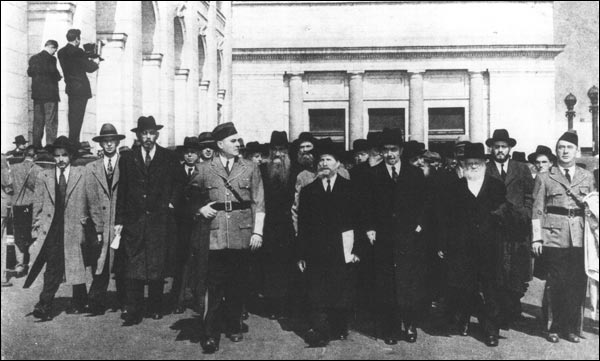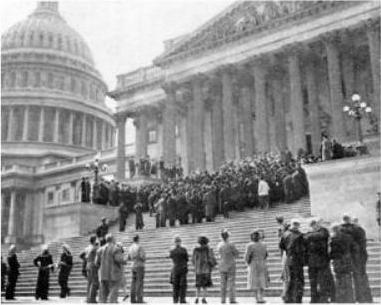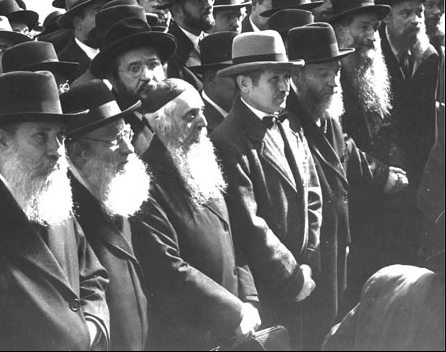by Rafael Medoff
(Dr. Medoff is director of The David S. Wyman Institute for Holocaust Studies.)
“Clear the way for those rabbis!” That was the first, and probably last, time the Station Master at Washington, D.C.’s Union Station shouted those words. The crowd before him was unlike any that had ever been seen in the central train station of the nation’s capitol. The date was October 6, 1943, three days before Yom Kippur and more than four hundred rabbis had come to plead for U.S. government action to save Jews from Hitler.
The march was the brainchild of 33 year-old Hillel Kook of Jerusalem, nephew of Abraham Isaac Kook, the first chief rabbi of British Mandatory Palestine. Kook, who used the pseudonym Peter Bergson, traveled to the United States in 1940 to lobby for U.S. support for Jewish immigration to Palestine and the creation of a Jewish state. After news of the Nazi genocide reached the United States in late 1942 and early 1943, Bergson established the Emergency Committee to Save the Jewish People of Europe, a political action committee that sought U.S. action to rescue Jewish refugees.

Bergson understood the need for dramatic tactics to publicize his cause. To alert the American public about the Nazi massacres, the Bergson group sponsored a theatrical pageant called “We Will Never Die,” authored by Academy Award-winning screenwriter Ben Hecht, which was viewed by more than 40,000 people at Madison Square Garden and then in other cities around the country. The Bergson activists also sponsored more than two hundred newspaper advertisements urging the United States government to rescue the refugees.
Bergson’s hard-hitting approach rattled some mainstream American Jewish leaders, who feared that loud protests might provoke antisemitism. Some Jewish leaders also feared that the Bergson group’s growing popularity might usurp their own positions of prominence in the Jewish community. Yet there were also pockets of sympathy for the Bergson group within the Jewish leadership. When the Bergsonites encountered difficulties arranging transportation for the rabbis, they approached veteran Hadassah leader Denise Tourover, of Washington, D.C., who provided logistical advice.
The actual task of recruiting the rabbinical demonstrators was handled primarily by the Va’ad HaHatzala, a U.S. Orthodox group that provided financial aid to beleaguered Torah scholars in Europe and had also been involved in lobbying U.S. officials to assist Jewish refugees. The Va’ad’s leaders were European-born scholars who mostly spoke Yiddish, and shied away from involvement in affairs beyond the confines of their religious community. But the crisis of European Jewry under Hitler impelled them to undertake unusual initiatives in the public realm, of which marching in Washington was perhaps the most unusual. In fact, it was to be the only rally in Washington on the rescue issue during the entire period of the Holocaust. The ideas of Jews marching through streets of the nation’s capitol, promoting specifically Jewish requests such as rescue, especially during wartime, was anathema to mainstream Jewish leaders.
 Most of the rabbis were from the New York area, but others came from Philadelphia and Baltimore, and some from as far away as Chicago, Cleveland, Cincinnati, Pittsburgh, Columbus, Connecticut, and Worcester, Massachusetts.
Most of the rabbis were from the New York area, but others came from Philadelphia and Baltimore, and some from as far away as Chicago, Cleveland, Cincinnati, Pittsburgh, Columbus, Connecticut, and Worcester, Massachusetts.
The rabbis who marched that day included some of the most prominent rabbinical figures in the American Jewish community, such as Eliezer Silver and Israel Rosenberg, co-presidents of the Union of Orthodox Rabbis; Solomon Friedman, president of the Union of Grand Rabbis; Bernard Dov Leventhal, known both as the chief rabbi of Philadelphia and one of the leaders of the Orthodox rabbinate nationwide; and Rabbi Moshe Feinstein, who would later come to be regarded as the leading authority in America on matters of Jewish religious law. The marchers also included an interesting array of hasidic rabbis side by side with rabbis known as mitnagdim, the traditional theological critics of hasidism.
According to an internal Bergson group document, some Jewish Congressmen “had done all they could to dissuade the Rabbis from making their bearded appearances in Washington.” Representative Sol Bloom of New York, who chaired the House International Affairs Committee and was a staunch supporter of the State Department’s refugee policies, led this effort, according to the Bergsonites. “At a certain moment they almost succeeded [in dissuading the rabbis] but Mr. Bloom spoiled the soup by telling one of the Rabbis, as an additional inducement for not going, that it would be very undignified for a group of such un-American looking people to appear in Washington. This created a lot of resentment and in the end instead of 250 Rabbis on whom we counted, we had to cope with 400.”
The rabbis, many wearing long black coats and black hats, marched solemnly from Union Station to the cluster of buildings known as the Capitol, accompanied by marshals provided by the Jewish War Veterans of America. They were met on the steps of the Capitol by Vice President Henry Wallace, who, Time magazine reported, “squirmed through a diplomatically minimum answer” to their plea. Wallace’s vague statement expressed “grief” at the plight of the Jews but made no reference to the possibility of rescuing any of them.
Also present to greet the marchers were a number of prominent Members of Congress, among them the Senate Majority Leader (and later vice president), Alben Barkley of Kentucky; the Senate Minority Leader (and unsuccessful 1940 vice-presidential candidate), Charles McNary of Oregon; and the Speaker of the House, U.S. Representative Sam Rayburn of Texas; and U.S. Senator W. Warren Barbour, Republican of New Jersey, a strong proponent of U.S. action to aid refugees. (Sadly, Barbour would die in office, at age 55, just six weeks after the march.)
 Two of the leaders of the march read aloud the group’s petition to the president, in Hebrew and English. “Children, infants, and elderly men and women, are crying to us, ‘Help!’,” they read. “Millions have already fallen dead, sentenced to fire and sword, and tens of thousands have died of starvation … And we, how can we stand up to pray on the holy day of Yom Kippur, knowing that we haven’t fulfilled our responsibility? So we have come, brokenhearted, on the eve of our holiest day, to ask you, our honorable President Franklin Roosevelt … to form a special agency to rescue the remainder of the Jewish nation in Europe.”
Two of the leaders of the march read aloud the group’s petition to the president, in Hebrew and English. “Children, infants, and elderly men and women, are crying to us, ‘Help!’,” they read. “Millions have already fallen dead, sentenced to fire and sword, and tens of thousands have died of starvation … And we, how can we stand up to pray on the holy day of Yom Kippur, knowing that we haven’t fulfilled our responsibility? So we have come, brokenhearted, on the eve of our holiest day, to ask you, our honorable President Franklin Roosevelt … to form a special agency to rescue the remainder of the Jewish nation in Europe.”
The protesters proceeded to the Lincoln Memorial, where they offered prayers for the welfare of the president, America’s soldiers abroad, and the Jews in Hitler Europe, and then sang the national anthem. Then they marched to the gates of the White House, where they had expected a small delegation would be granted a meeting with President Roosevelt. Instead, to their surprise and disappointment, they were met by presidential secretary Marvin McIntyre, who told them the president was unavailable “because of the pressure of other business.”
In fact, the president’s schedule was remarkably open that afternoon. His daily calendar listed nothing in between a 1:00 lunch with the Secretary of State and a 4:00 departure for a ceremony at an airfield outside Washington. The real reason FDR declined to meet the rabbis was that he had been urged to avoid them by his speechwriter and adviser Samuel Rosenman (a prominent member of the American Jewish Committee) and Dr. Stephen Wise (president of the American Jewish Congress), who were embarrassed by the protesters and feared the march might provoke antisemitism.
In his diary, presidential aide William D. Hassett noted that Rosenman “said the group behind this petition [is] not representative of the most thoughtful elements in Jewry. Judge Rosenman said he had tried–admittedly without success–to keep the horde from storming Washington. Said the leading Jews of his acquaintance opposed this march on the Capitol.” Rosenman reportedly characterized them as “a group of rabbis who just recently left the darkest period of the medieval world.” Wise condemned “the orthodox rabbinical parade” as a “painful and even lamentable exhibition.” He derided the organizers as “stuntists” and accused them of offending “the dignity of [the Jewish] people.” Roosevelt decided to leave the White House through a rear exit.
The problem was not only the advice that prominent Jews gave FDR; it was also that the pleas for rescue clashed with the administration’s entire approach to the plight of European Jewry. During the 1930s, Roosevelt had barely said a word about Hitler’s persecution of German Jews. He refused to consider taking any diplomatic or economic steps to pressure Germany on the Jewish issue. Not only did he reject appeals to liberalize America’s strict immigration quotas, but his administration implemented such cumbersome procedures for immigration visas –procedures described by David Wyman as “Paper Walls” in his book of that name– that only a small portion of the quotas were used each year.
Even after the news of the Nazi genocide was confirmed in late 1942, Roosevelt refused to alter his policy. He almost never mentioned the Jews when condemning Nazi atrocities. Immigration quotas remained unfilled–sometimes 90% unfilled. The refugee conference that his administration and the British staged in Bermuda in April 1943 was designed as a cover for the Allies’ policy of indifference. This was based on a cold political calculation. FDR knew that most Americans were opposed to letting in more refugees, and he assumed that any other steps taken by the U.S. to help refugees, even short of bringing them to the U.S., would be equally unpopular. Thus the president claimed there was nothing that could be done for the Jews until after the U.S. and its allies defeated Germany in the war. Administration officials described their approach as “rescue through victory.” But Jewish leaders feared if they waited until victory was attained, there might be no Jews left in Europe to rescue.
If the president thought he could avoid this controversy by avoiding the rabbis, he was mistaken. The next day’s newspapers told the story. “Rabbis Report ‘Cold Welcome’ at the White House,” declared the headline of a report in the Washington Times-Herald. A columnist for one Jewish newspaper angrily asked: “Would a similar delegation of 500 Catholic priests have been thus treated?” The editors of another Jewish newspaper, Forverts (Forward), reported that the episode had affected the president’s previously-high level of support in the Jewish community: “In open comment it is voiced that Roosevelt has betrayed the Jews.”
Meanwhile, just as the Bergson campaign of pageants, newspaper ads, and demonstrations was reaching its peak, several senior aides to Treasury Secretary Henry Morgenthau Jr. discovered that State Department officials had been secretly obstructing rescue opportunities and blocking transmission of Holocaust-related information to the U.S. The State Department did not want them to be rescued, because that would increase pressure on the Allies to give them shelter. Although his aides urged Morgenthau to take the matter directly to the president, he hesitated, hoping that polite appeals to the Secretary of State might suffice to change U.S. policy toward Europe’s Jews.
The pressure of Morgenthau’s aides finally convinced him to go to the president, armed with a stinging 18-page report that they titled “Report to the Secretary on the Acquiescence of This Government in the Murder of the Jews.” At the same time, on Capitol Hill, the Bergson group used the public pressure it had built to launch a major new initiative in Congress–a resolution calling for the creation of a U.S. government agency to rescue refugees. The Roosevelt administration opposed the resolution, fearing it would increase pressure to let refugees come to the U.S. But its effort to block the resolution foundered when the State Department’s top immigration authority, Breckinridge Long, gave wildly misleading testimony at the hearings on the rescue resolution.
The embarrassing publicity from the hearings opened the door to Morgenthau’s pressure on the president. With the rescue resolution already having passed the Senate Foreign Relations Committee, Morgenthau bluntly told FDR that “you have either got to move very fast, or the Congress of the United States will do it for you.” Ten months before election day, the last thing FDR wanted was an embarrassing public scandal over the refugee issue. Within days, Roosevelt did what the Congressional resolution sought–he issued an executive order creating the War Refugee Board, a U.S. government agency to rescue refugees from Hitler.
During the final fifteen months of World War II, the Board played a crucial role in saving the lives of some 200,000 Jews. Approximately 15,000 were evacuated from Axis territory (as were more than 20,000 non-Jews). At least 10,000, and probably additional thousands, were protected within Axis Europe by Board-financed underground efforts and by the board’s steps to safeguard holders of Latin American passports. The Board’s diplomatic pressures, backed by its program of psychological warfare, were instrumental in bringing about the transfer of some 48,000 Jews in Transnistria to safe areas of Rumania.
Similar pressures eventually helped put a stop to German deportations of Jews from Hungary the Hungarian deportations, and ultimately, 120,000 Jews survived in Budapest. The Board assisted and financed the work of rescue hero Raoul Wallenberg, the Swedish diplomat who sheltered Jews in Budapest (including future U.S. Congressman Tom Lantos and his wife-to-be, Annette.) The Board helped save additional lives –although it is impossible to estimate how many– by engineering war-crimes warnings by the Allies and the shipment of thousands of food parcels into Nazi concentration camps near the end of the war.
When the rabbis set out for the White House on that chilly October afternoon, they had no way of knowing if their effort would have any impact. When they recited their Yom Kippur prayers three days later, all they knew was that they had fulfilled their moral obligation–to try. But as the months passed and the successes of the War Refugee Board became known, they could feel proud that they had played a role in making it possible.v
For Further Reading:
Alex Grobman, Battling for Souls: The Vaad Hatzala Rescue Committee in Post-War Europe (Jersey City, NJ: Ktav, 2003). See pp. 35-52.
Rafael Medoff, The Deafening Silence: American Jewish Leaders and the Holocaust (New York: Steimatzky-Shapolsky, 1987). See pp. 130-131.
Rafael Medoff, Militant Zionism in America: The Rise and Impact of the Jabotinsky Movement in the United States, 1926-1948 (Tuscaloosa, AL: University of Alabama Press, 2002). See pp. 97-98.
M. J. Nurenberger, The Scared and the Doomed: The Jewish Establishment vs. the Six Million (Ontario: Mosaic Press, 1985). See pp. 197-204.
Louis Rapoport, Shake Heaven and Earth: Peter Bergson and the Struggle to Rescue the Jews of Europe (Jerusalem: Gefen, 1999). See pp. 109-111.
David S. Wyman, The Abandonment of the Jews: America and the Holocaust 1941-1945 (New York: Pantheon, 1984). See pp. 152-153.
David S. Wyman and Rafael Medoff, A Race Against Death: Peter Bergson, America, and the Holocaust (New York: The New Press, 2002). See pp. 41, 112-114.
Efraim Zuroff, The Response of Orthodox Jewry in the United States to the Holocaust: The Activities of the Vaad-ha-Hatzala Rescue Commitee, 1939-1945 (Yeshiva University Press, 2000). See pp. 257-264.
